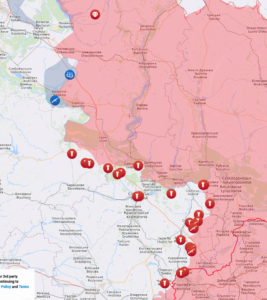There are indications that Ukraine, in addition to the Kherson counteroffensive, is conducting a counteroffensive in Kharkiv Oblast, and has apparently captured Volokhiv Yar, Balakliya and Yakovenkove, towns between Kharkiv and Russian-occupied Izyum.
It’s unclear whether this is a feint, a spoiling attack or a full-blown counteroffensive, but the scale of the initial success suggests it’s too large to be a mere probing attack.
Ukrainian forces conducted a counterattack in Kharkiv Oblast near Balakliya that likely drove Russian forces back to the left bank (north side) of the Severskyi Donets and Serednya Balakliika rivers on September 6. Ukrainian forces likely captured Verbivka (less than 3 km northwest of Balakliya) on September 6. Geolocated footage posted on September 6 shows Ukrainian infantry in eastern Verbivka (less than 3 km from Balakliya). Multiple Russian sources acknowledged Ukrainian gains in Verbivka and reported that Russian forces demolished unspecified bridges in Balakliya‘s eastern environs to prevent further Ukrainian advances. Images posted on September 6 also show a destroyed Russian bridge over the Serednya Balakliika River—a geographic feature behind which the Russian front line in this sector likely lies. Social media users reported that Russian forces withdrew from checkpoints six kilometers west of Balaklia on September 6.
Russian forces likely no longer maintain their previous positions in Bairak and Nova Husarivka (just south of Balakliya on the right bank of the Seversky Donets River). Russian forces likely abandoned Bayrak and Nova Husarivka in late August. Images posted on August 30 show that Russian forces blew the bridge over the Seversky Donetsk River near Bayrak on an unspecified date. Bridge demolition activity indicates a planned Russian withdrawal. Ukraine’s General Staff reported on September 6 that Russian forces conducted air strikes against Bayrak, indicating that Ukrainian forces may have advanced in the area.
Russia’s deployment of forces from Kharkiv and eastern Ukraine to Ukraine’s south is likely enabling Ukrainian counterattacks of opportunity. The September 6 Ukrainian counterattack in Kharkiv was likely an opportunistic effort enabled by the redeployment of Russian forces away from the area to reinforce Russian positions against the Ukrainian counteroffensive in Kherson Oblast. Obituary data on Russian servicemen indicates that Russia deployed elements of the 147th Artillery Regiment of the 2nd Motorized Rifle Division of the 1st Guards Tank Army to Kherson Oblast no earlier than late August. This is the first time ISW has observed elements of Russia’s elite 1st Guards Tank Army operating in southern Ukraine. Elements of the 147th previously fought in Bucha in Kyiv in March and elements of the 1st Guards Tank Army were active primarily along the Kharkiv Axis after the Russian withdrawal from Kyiv.
Reporting from Ukraine (a pro-Ukrainian source) breaks down the counteroffensive.
Suchomimus analyzes the news as of yesterday. There are “reports that Russia is blowing up bridges, a sign that they are in a bit of a panic and expect Ukraine to advance.”
And here he shows a video of Ukrainian forces entering Yakovenkove further east, from which he surmises that they must have already taken Balakliya.
Bonus: Ukrainian aircraft shoots down a Russian Su-25:
Map snapshot, which is already slightly out of date:

Izyum is the linchpin of Russia’s north-central front. Losing it would not only spell an end to any further Russian advances in Kharkiv for the immediate future, but also put Russia’s hard-won conquest of Severodonetsk and Lysychansk in jeopardy.
With Russia reportedly buying artillery from North Korea (Caveat: This comes from Biden’s Pentagon, so grains of salt are in order) and two separate counteroffensives chewing up units, it’s possibly that Russia’s territorial gains in Ukraine have already peaked.
Edited to add: Reporting from Ukraine has a video up detailing how different thrusts of the counteroffensive developed: